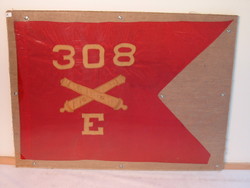

Obverse
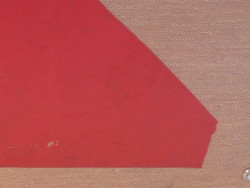
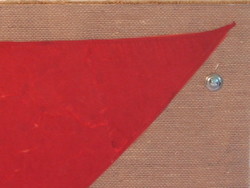
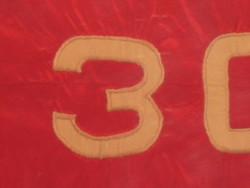


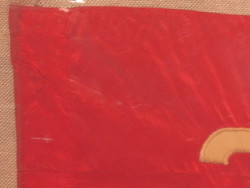
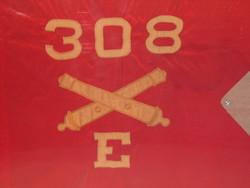
Obverse Zoom
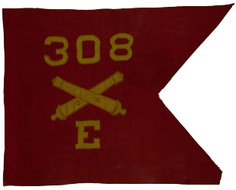
Book Photo
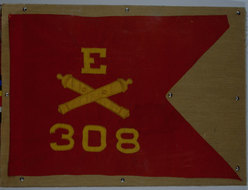
Reverse - Inverted
U.S. Army Artillery Guidon, WWI.
Sub-collection: U.S. MilitaryU.S. Army 308th Arty. Guidon Battery E, WWI.
Until 1886 the light artillery - field artillery - companies of the U.S. Army had traditionally used the same guidons in field maneuvers as the cavalry. Beginning that year, the artillery was provided with new regimental flags and battery guidons that matched their branch color. Those flags were red and bore the traditional crossed cannon insignia of the artillery. The guidon was completed by addition of the regimental number and the battery letter, the latter below and the former above the crossed cannons.
The 308th was part of the National Army formed during World War One. It was raised in New York, New Jersey, and areas of Pennsylvania adjacent to them as a part of the 78th Division. The 78th was nicknamed the "Lightning Division" by the French, because the battlefield looked as if it had been struck by lightning after they fought there.
Until 1886, the field artillery and light companies in the United States Army traditionally used the same guidons in the battle field within the cavalry service. However, in 1886 that all changed and the artillery was provided with new battery guidons as well as flags that matched their branch colors. Those flags were red and bore the traditional crossed cannon insignia of the artillery. The guidon was completed by addition of the regimental number and the battery letter, the latter below and the former above the crossed cannons.
The 308th was part of the National Army formed during World War One. It was raised in New York, New Jersey, and areas of Pennsylvania adjacent to them as a part of the 78th Division. The 78th was nicknamed the "Lightning Division" by the French, because the battlefield looked as if it had been struck by lightning after they fought there.
This particular guidon conforms to the pattern that was adopted for field artillery batteries back in 1886 but unusually it is made from bunting, which is a feature that was not used in guidons until 1890. As mentioned, this guidon belonged to the 308th Field Artillery Regiment, Battery (Company) E and it was used in federal service during World War I.
This flag is cut into a swallow-tailed shape and is made of red bunting. It has been stitched with a machine and in the center there are two crossed cannon barrels that are yellow in color and also a letter "E" and the figures "308". The flag is attached with a sleeve that was formed by doubling the flag over and the hoist edge of the flag has then been stitched into place.
Exhibition History
First Presidio Exhibit
United States Army Model 1886 Artillery Guidon, Battery E, 308th U.S. Field Artillery
Second Presidio Exhibit, 2003 - GALLERY VI
(ZFC0267)
United States Army Model 1886 Artillery Guidon Bat. E, 308th U.S. Field Artillery
Publication History:
Madaus, Howard M., Dr, Whitney Smith, The American Flag: Two Centuries of Concord and Conflict. Santa Cruz: VZ Publications, 2006, p. 120.
Provenance: Acquired by the Zaricor Flag Collection (ZFC0267) in 1997 from the Baltimore Antique Gun show, Baltimore, MD.
ZFC Important Flag
Item is Framed
Sources:
Madaus, Howard M. - Whitney Smith, The American Flag: Two Centuries of Concord and Conflict, VZ Publications, Santa Cruz, 2006.
Quartermaster General US Army, U.S. Army Uniforms and Equipment, 1889, reprint, University of Nebraska Press, Lincoln, 1986, pp. 132.
Guidon, Wikipedia, 22 April 2012, from: http://en.wikipedia.org/wiki/Guidon_%28United_States%29
Hoist & Fly | |
|---|---|
| Width of Hoist | 40 |
| Length of Fly | 27 |
Stripes | |
|---|---|
| Size of Hoist | 2.25 |
Frame | |
|---|---|
| Is it framed? | yes |
| Frame Height | 38.5 |
| Frame Length | 49.5 |
Stars | |
|---|---|
| Are there stars on obverse? | no |
| Are there stars on reverse? | no |
Stripes | |
|---|---|
| Has a Blood Stripe? | no |
Crest/Emblem | |
|---|---|
| Description of Crest/Emblem | 2 canons + Text : "308 E" |
Nationality | |
|---|---|
| Nation Represented | United States |
Stitching | |
|---|---|
| Stitching | Machine |
Attachment | |
|---|---|
| Method of Attachment | Sleeve |
Documentation | |
|---|---|
| Documents |
All original documents and drawings are held in the Zaricor Flag Collection Archives.
|
| Drawings |
All original documents and drawings are held in the Zaricor Flag Collection Archives.
|
Condition | |
|---|---|
| Condition | Good |
| Damage | Bottom right corner ripped off |
| Displayable | yes |
Date | |
|---|---|
| Date | 1917 |
Exhibits | |
|---|---|
| Exhibition Copy | First Presidio Exhibit (ZFC0267) UNITED STATES ARMY MODEL 1886 ARTILLERY GUIDON, BATTERY E, 308TH U.S. FIELD ARTILLERY Date: 1917-1918 Media: Wool bunting with cotton inscriptions; machine sewn Comment: The light or field artillery companies of the United States Army until 1886 had traditionally used the same guidons in field maneuvers as the cavalry service. In 1886, that changed, and the artillery was provided with new regimental flags and battery guidons that matched their branch colorredand bore the crossed cannon insignia of the artillery branch. The regimental number and the battery letter completed the guidon design, with the latter above and the former below the crossed cannons. When the United States entered World War I, the numerous state national guard units were absorbed into the U.S. Army and assigned regimental numbers in the U.S. Army. In this case the old state designation became the 308th U.S. Artillery, Battery E. Provenance: Acquired by the Zaricor Flag Collection (ZFC0267) in 1997 from Baltimore Antique Gun show, Baltimore, MD. Second Presidio Exhibit, 2003 - GALLERY VI (ZFC0267) United States Army Model 1886 Artillery Guidon Bat. E, 308th U.S. Field Artillery Date: 19171918 Media: Wool bunting with cotton inscriptions; machine-sewn Comment: Until 1886 the light artillery (field artillery) companies of the U. S. Army had traditionally used the same guidons in field maneuvers as the cavalry service. Beginning that year the artillery was provided with new regimental flags and battery guidons that matched their branch color. These flags were red and bore the crossed cannon insignia of the artillery branch. The regimental number and the battery letter completed the guidon design, the latter being above and the former below the crossed cannons. When the United States entered World War I, the numerous state national guard units were absorbed into the U.S. Army and were assigned regimental numbers in the U.S. Army. In this case the old state designation became the 308th U.S. Artillery, Battery E. Provenance: Acquired by the Zaricor Flag Collection (ZFC0267) in 1997 from the Baltimore Antique Gun show, Baltimore, MD. |
Publications | |
|---|---|
| Publication Copy | Madaus, Howard M., Dr, Whitney Smith, The American Flag: Two Centuries of Concord and Conflict. Santa Cruz: VZ Publications, 2006, p. 120. U.S. Army Model 1886 Artillery Guidon Battery E, 308th U.S. Field Artillery. Until 1886 the light artillery field artillery companies of the U.S. Army had traditionally used the same guidons in field maneuvers as the cavalry. Beginning that year, the artillery was provided with new regimental flags and battery guidons that matched their branch color. Those flags were red and bore the traditional crossed cannon insignia of the artillery. The guidon was completed by addition of the regimental number and the battery letter, the latter below and the former above the crossed cannons. The 308th was part of the National Army formed during World War One. It was raised in New York, New Jersey, and areas of Pennsylvania adjacent to them as a part of the 78th Division. The 78th was nicknamed the Lightning Division by the French, because the battlefield looked as if it had been struck by lightning after they fought there. Date: 1917 1918 Size: 27" hoist x 40" fly Medium: Wool bunting with cotton inscriptions; machine-sewn Provenance: Acquired by the Zaricor Flag Collection in 1997 from the Baltimore Antique Gun Show, Baltimore, MD. ZFC0267 |
| Publication Images | |

